For an awesome tool to quantify weaknesses, fix those weaknesses, control common aches and pains, and all things recover, check out our new book “No Weaknesses. Check it out here:
The Brand New Mash Elite E-Book: “No Weaknesses”
Join Team Mash Mafia for weightlifting, powerlifting, athletic performance, bodybuilding, running, or a hybrid approach. This team is already taking over weightlifting, and I plan on taking over all of the other disciplines one at a time. Check it out below:
The Split Jerk’s Not Simple, but It’s Easy! by Don McCauley
Don McCauley’s article on the Jerk will conclude my series of teaching the Big Five: Snatch, Clean & Jerk, Squat, Bench Press, and Deadlift. Soon I will be coming out an advanced version of all six (because I divided the Clean and the Jerk) of the main lifts complete with workouts, videos, and more. Make sure that you are signed up for the Newsletter because that will be the only way that you receive this series. Now enjoy Don McCauley’s article on the almighty Jerk.
There aren’t too many things that upset a weightlifter more than to stand up with a clean, hard or easy, and then proceed to miss the jerk. Yes, missing a snatch is always a pain but you know that it is a very technical lift and is more likely to be missed. But the JERK is simple…down-up-down and split front and back. All of these are basic movements with no “around the knees”, “pull-under”, “readjustment” and “not finishing the pull” to worry about. Down-Up-Down and split front and back. Simple. Right? Well, how come we keep missing them?
The problem, as it often is in weightlifting, is that we are projecting a bar somewhere over our head in the Jerk and the bar in this case is sitting in front of our neck, laying across the collarbone behind our front deltoid and it’s fairly uncomfortable…and it seems to want us to tilt towards it…and it’s heavy. Although we know the bar has to be driven over our head, ideally over and slightly behind the head, to arm’s length, our brain has much more stored information about the tendency to move us forward, not down-up-down and then split in its movement memory. It prefers us to go that way. So what generally happens is the brain, wanting to get to the part it is comfortable with, has you lean or drift into the step forward it knows is coming in the Split before finishing that bothersome and unusual down-up-down movement and, of course, you miss the Jerk because you’ve never finished the drive portion of the lift or you drive the bar into the head judges lap. So, what to do???
This is what I do when teaching the Split Jerk to make your brain commit to doing the dip and drive, which is, by far, its most important movement first: 1) show the body position right at the starting position and in the split, 2)explain to the lifter where the balance should be on the feet at the start and throughout the dip and drive and in the split, 3) not talk much at all about the split and 4)explain the Split Jerk as an down-up-down motion ONLY! What I try to do is to take the idea that there is a forward movement out of the equation to allow the brain to have less to think about and not allow it to go to its preferred movement instead of the one I want the lifter to put his/her major effort into: that being driving the bar upward quickly. My reasoning here is that if the lifter doesn’t make the dip and drive the priority, he’s not likely to ever be as good a jerker as he might. Now, just to settle a question you might have here: “Is there forward motion in the Split?” Wellll, just a bit but it’s not worth mentioning, so I won’t.
This is how I set a person up for the jerk. In the Split Jerk, you start in the standing position, your back in a vertical position with the balance over the rear of your feet. The bar should be set in the natural groove created when you clean the bar that rests it across your collarbone and behind the front deltoid , hands on the bar in a position wider than your shoulders, the bar in your palms, if possible, and your elbows pointed somewhere below horizontal. Your legs should be straightened but not stiffened at the knees and with your feet under your hips and pointed slightly to the outside. You need to be aware that your back is tightened and will travel on a perfectly vertical track down and up and down again during the dip/drive/split motions as if the upper back between the shoulder blades and the tailbone are on that vertical track and can’t leave it, no more than a train can leave its horizontal one. 1) set, 2) dip, 3) drive. Oh, and take a breath in and hold it through the dip and into the start of the drive.
To dip, you ALLOW your knees to travel forward in the direction of the toe point, keeping your hips over the rear of the feet and keeping that back on the vertical track downward (btw, the dip, for most, is not an accelerating movement but almost a simple falling one). After a few inches of descent, you DRIVE back upwards, staying over the rear of the feet and deliver an explosive force up through your torso, which is sort of like a battering ram going vertical, causing the bar to accelerate upwards from it. A word here: DO NOT try to accelerate the bar upwards by a shrugging movement of the shoulders. This is wrong. And DO NOT consciously try to push upward through your forefeet to make the bar go higher. This too is wrong. As the bar accelerates upward from your torso, you will punch your arms and shoulders upward and punch your feet downward, one slightly to the front and one slightly to the back, but downward is the thought you should have. The rear foot should be plantar flexed to a good degree in mid-air as this movement occurs and the sole of the front foot should be kept rather horizontal. The rear foot should touch down first and that leg should be preset in midair with a slight bend at the knee.
This touchdown of the rear foot actually starts a slight movement forward of the lifter but it won’t be sensed. The lifter will feel he is staying in place. The front foot, immediately after the back foot touches down, will be driven forward and down and you should land with your force going downward through the heel and the shin vertical or slightly pointed back at you. (There is a 1-2 or Bam, Bam sequencing here, back foot touching down first and front second) So, the legs should be thought of more as stakes driven into the ground than limbs stepping, splitting or lunging. The length of the split will be determined by how powerful the lifter in first, driving the bar and then moving his feet and how technically sound the split is, NOT some arbitrary distance he is to “step through”. The bars position overhead will be determined by the correctness of your dip and drive technique. It should end up at arm’s length (wrists bent back, by the way) slightly behind your head and above your shoulders.
Should you try to get low or long in the split? NO. Should you even think of the split during the lift? NO. Should you try to land both feet at the same time? NO. Are there other parts of this lift that you didn’t go over? YES…..but this movement and position is the most important thing you have to know to be successful at the Jerk. I will guarantee that if you get the dip and drive correct, you will have a high percentage chance of making the Jerk, even if it isn’t pretty. If you don’t, your chance of making the split jerk go way down.
Should the feet in the Split stay at least as far apart horizontally as they were at the start of the movement? YES. The feet should never split and move toward a centerline creating a tightrope position but mark the diagonally opposed corners of an imagined rectangle on the floor.
Should the feet be turned inward or be straight? They should both be turned inward for most, especially the front foot. Remember the front and back legs are driven down as stakes in the ground to stop movement, not as legs and feet going for a walk or lunge. People walk with their feet pointing forward or even outward. Turning them inward tells the brain that this is NOT a walk.
Should you tighten the quads primarily to stiffen the Split upon landing? NO. You should squeeze your butt cheeks together as the split is completed. This will hold your torso in a vertical and centered position in the split and not put the whole job on the legs. This, in turn, allows your legs more easily to start the recovery to the final standing position with the bar overhead.
Isn’t that one-two landing of the feet in the split too much to think about rather than just have them both land at the same time? Do you walk every day or do you hop? One-two is the way we move.
Should I walk forward pushing off my back foot to recover? The answer for almost everyone is NO. Recover from the split from the front foot by slightly straightening the leg, although not to a locked knee position and pushing backward off the HEEL, not the front of the foot. This should make you lift the front of your foot. Quickly do 1 or 2 of these push back steps until you have risen enough to comfortably bring your back foot up to be even with your front.
These questions come up all the time. If I think DRIVE DOWN with my legs rather than forward and back, won’t the split be too short and won’t I fail to step through enough? NO it won’t and NO you won’t. Your arms will punch upward against the bar and will drive you downward to the level you need and your feet will split to the natural distance they need as well. By the way, I never tell lifters to “get under the bar” or “step through” during the split jerk. Rather I tell them to “get tall” and “drive up” at the start of the jerk. I know, in fact, that they will move both downward and just slightly forward but in my mind emphasizing those things won’t improve the split jerk. Driving the bar upwards and getting the feet back on the platform quickly will. So, I emphasize that in my cueing.
Shouldn’t I just DROP my back knee to keep it under the hip in the split? NO. The knee is not just dropped to a position in the split but driven to it with accelerating movement. Your back knee may or may not end up vertically under your hip but it is not an absolute necessity by any means. If you doubt this, check the many videos of world class weightlifters on YouTube. The knee position in the split is determined by overall leg length, femur and tibia relative length, flexibility in the hip, knee and ankle and finally, the weight on the bar.
So, those are some of my ideas about how to look at and perform the Split Jerk. There are drills that should be done before doing Jerks and the positions should be fully explained by your coach but to me, the concept of it being a down-up-down movement is the one that will eventually make you a successful Split Jerker rather than an image of striding into the split being the emphasis in teaching. Hope this has helped clear some things up for some of you. If you have any questions, contact me on Facebook and I’ll be happy to answer them for you.
Follow Coach McCauley on Instagram @D.J.Mac
-Coach Don McCauley
Guys and gals, if you want a tool that will help you along your fitness path, I would be honored if you checked out the brand new “No Weaknesses” E-Book. For more information, click on the link below:
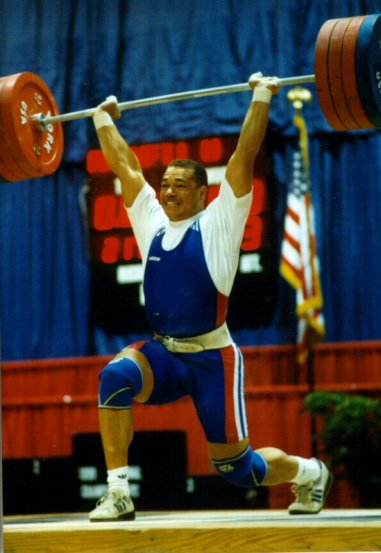
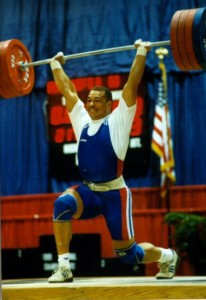
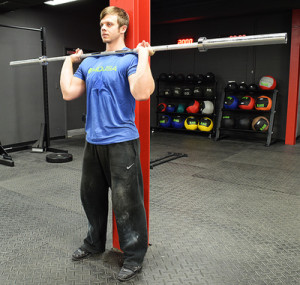
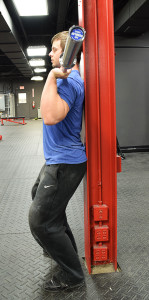
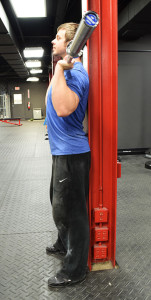
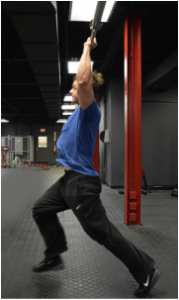


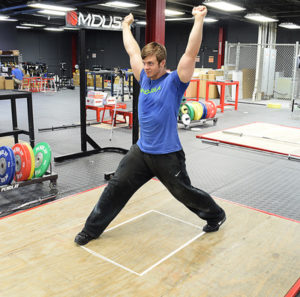
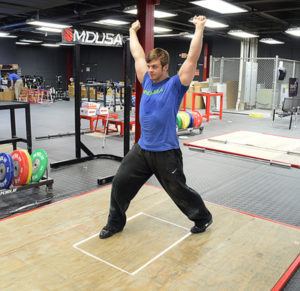
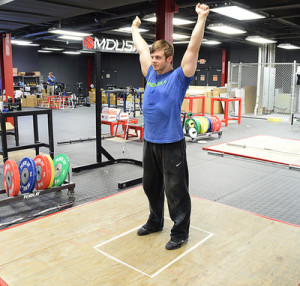

Pingback: Fixing Your Jerk